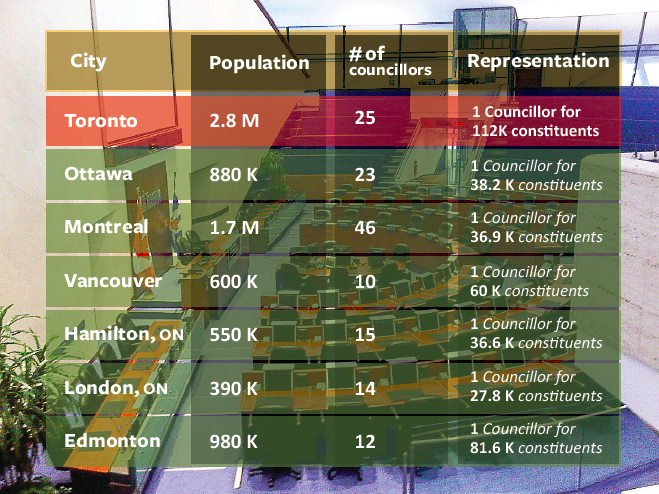On July 27th 2018, the last day for candidates to register in the upcoming Toronto municipal election in October, newly elected Premier Doug Ford decided to change the game in the middle of the election. Ford decided to cut council from 47 wards to 25 wards – a decision that has left city officials scrambling to adjust and has left voters confused.Ford’s reduction of council seats will result in ward populations doubling in size. Communities like ours will feel the squeeze, as the newly elected councillors will struggle to keep up with the needs of the amalgamated neighbourhoods and to speak to residents who desire to contact their councillor.While the federal and provincial layers of government are the decision makers on a broader scale, councillors and city staff handle the day-to-day local services that are the lifeblood of our municipalities. Transit, roads, water, parks, housing and social services are all examples of what falls under the City’s umbrella.The reduction in council has left Toronto with 25 councillors for a population of 2.8 million people – meaning there will be on average 1 councillor for every 112,000 people. For comparison, the city of Ottawa has 23 councillors for a population of 950,000 has on average 1 councillor for every 41,304 people. The difference in representation is staggering – compared to other Ontarian towns and municipalities, Torontonians are going to have the least representation at City Hall.Ford’s decision was an indication of a personal vendetta against our city rather than a way to find real financial efficiencies. The conclusion of studies conducted by the City itself determined that we needed three more wards in order to serve our population appropriately. A growing city requires greater representation, and anything less would be undemocratic.Meddling in the midst of an election period wastes the money of taxpayers and candidates alike. Candidates now have had to adapt to sudden changes that they were not a part of, after all, Ford did not publicly promise to change the size of council during the provincial election.The city clerk’s office was already well underway in terms of planning and paying for the election; the original budget of $17.5 million is now up in the air due to wasted funds and the broadcasted potential spending required to accommodate the changes. Recalculating spending limits and paying to communicate the new boundaries is a weight on the election period. It is not fair for the premier to have interfered in the election without our permission and to waste our hard-earned tax payer dollars.Here in our part of the city, Ward 7, 8 and a portion of Ward 9 will merge to match the provincial boundary lines. This means that two longstanding incumbents are competing against each other for the same ward, which is yet to be officially named. Councillor Anthony Perruzza is known as a hardworking, honest and approachable councillor from Ward 8. George Mammoliti is the infamous councillor from Ward 7 known for his boisterous commentary above all else.In a 25 ward model motions that can be detrimental to marginalized groups and that center profit over people only need 13 votes to pass. This makes it much easier for local interests to be overlooked in the interest of others. It makes city hall a much more easy place to manipulate for those with money and lobbying powers.As residents, we need to do our research and reflect on what is best for our communities and Toronto. We must remember that the decrease in councillors effects how our city is shaped and every vote and voice in council counts twice as much. On October 22nd, let us make sure that Toronto and our community are not left behind.
2 Champagne Drive - Unit C9
Toronto, Ontario, M3J 0K2
(647) 478-8752
The Voice of Downsview
Your Custom Text Here

